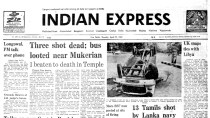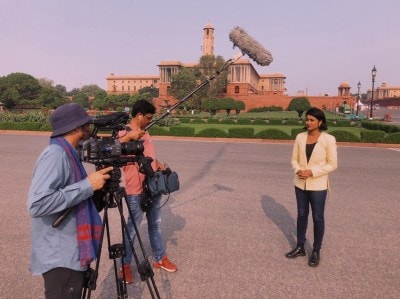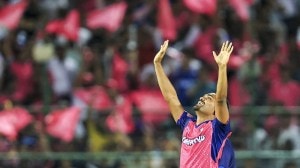- India
- International
While Rahul stood still
Kejriwal has surged ahead, filling up Congress space in Delhi. Can Congress still pick up the pieces?
 It was a different Kejriwal who swore allegiance to the Constitution as he took oath as chief minister for the second time on Saturday.
It was a different Kejriwal who swore allegiance to the Constitution as he took oath as chief minister for the second time on Saturday.
You cannot speak to the same Ramlila Maidan assembly twice. When Arvind Kejriwal took oath as Delhi’s chief minister for the second time at the Maidan, it was not the same crowd. And he is not the same man.
On a Sunday morning about three and a half years ago in August 2011, Kejriwal was the backroom strategist who made an overlong speech that delayed the breaking of Anna Hazare’s 13-day fast well beyond the announced time of 10 am at Ramlila Maidan. For 13 days, the diminutive Anna had held the stage, looking wan and Gandhian, while his team went into huddles, and groups of mostly young men moved across the Maidan, beating drums, waving flags, and taking selfies to commemorate a first-time public outpouring. It was a festival of anger and frustration.
The slogans were against corruption. Against politics. Against nothing in particular. “Sonia jiski mummy hai, woh sarkar nikammi hai”. “Desh ke gaddaron ko, goli maaro saalon ko”. “Ham se jo takrayega, choor choor ho jayega”. On that Sunday, in his speech, Kejriwal made a distinction between helpless party MPs and their all-powerful high commands. We didn’t say all netas are thieves, he said, we are not against the Constitution, we respect Babasaheb Ambedkar. His attempt to nuance and deny only underscored the scorn that had been heaped on the whole political class from the stage in those 13 days . The crowd, high on itself and the moment, seemed not to notice.
It was a different Kejriwal who swore allegiance to the Constitution as he took oath as chief minister for the second time on Saturday, acknowledged his defeated opponents and pledged to work with the Centre. It was a different crowd that heard him, with expectation instead of anger, at the Ramlila Maidan. Politics has moved on, the political moment had changed.
Of course, like Hazare’s India Against Corruption, the AAP has an overdeveloped sense of its own exceptionalism and a similar self-righteousness. Yet Kejriwal and his party seem less angry. We will look for solutions, they say.

Was Kejriwal swept away from that 2011 moment by the force of events beyond his control — the unpopularity of the scandal-riddled UPA regime then, and the dimming of the Modi government’s sheen now? Have they thrust on him his new mellowness and role? Or did Kejriwal take charge with his unflagging door-to-door campaign, and bring on the change? It may still be too early to answer those questions.
For another man, however, who also sought to cast himself as the agent of change, time seems to have stopped. Rahul Gandhi appears caught in a standstill of his own making.
About six months after Anna Hazare called off his fast at the Ramlila Maidan in 2011, Rahul Gandhi touched down at Shahbad in district Rampur during UP’s assembly campaign. At a rally in a dusty ground, his message sounded uncannily similar to Team Anna’s as he played the Outsider. “They say Rahul Gandhi has gone crazy. They laugh at me, because I go to the homes of the poor, drink water from their wells. I will take your concerns to Delhi”, he told the crowd. “Your voice will be heard in the Lok Sabha. I will not go away. Till UP stands on its feet, I will stay”.
It was a message that did not just seek to vault over MLA, MP, party and government, but also his specific audience and setting. Many of those who had come to listen to Rahul, and lingered after his helicopter took off, shared with this reporter the problems they wrestled with daily: no public transport to or from Shahbad after 7 pm; no degree college for girls; no woman doctor in the government hospital where the nurse delivers babies and patients are asked to bring their own candles because power supply is irregular; no jobs.
Of course, Rahul’s positioning was much more complicated than Anna’s — he was crown prince of the party that ran the government that presided over the system he railed against. But at the core, in Anna’s posture as well as Rahul’s, was an ungrounded anti-ism; the exhortation was to trust the Good Man, not the System.
As the baton passed from Team Anna to Team Kejriwal, however, its basic message changed. The larger-than-life Lokpal envisaged by the former has been relegated by the latter’s promises to find solutions for bijli-paani problems. The AAP has climbed down from the stage and ventured deeper into its audience. By going to the people, by returning and staying on even after the Lok Sabha rout, Kejriwal’s party has persuaded Delhi voters that it has the answers to their specific crises, or at least the intent to search for them.
Rahul, on the other hand, still relies on the irregular touchdown, like the one in Shahbad, and the sporadic intervention, most recently in South Delhi’s Rangpuri Pahari. They have taken him no closer to the concerns of the people he addresses, or to winning their confidence.
In a way, Kejriwal is where he is today because Rahul stands where he was. And though India Against Corruption began as an anti-Congress mobilisation, and the AAP denies it has any models in the existing system, Kejriwal’s party has slid into the Congress’s space in Delhi in a way that suggests that it could grow up to be the Congress.
In its original promise, the Congress was a coalition, especially of the disprivileged, and a safe house for Dalits and minorities. Traditionally, the Congress’s vote increased as you went down the caste and class ladder, while it decreased for the BJP. Of course, in 2014, the Modi wave flattened many of these divisions, cashing in on an across-board yearning for change.
In the Delhi elections, the AAP polled more votes than the BJP in all classes, but post-poll data shows that it raced most dramatically ahead in the underclass. And there has been a dramatic consolidation of Muslim and Dalit votes in its favour. The AAP may not have started out this way, therefore, and it may not even have aimed for this, but its social profile today is that of a party of the minorities and the poor — like the Congress of an earlier day.
For now, though, the AAP has filled up a Congress shaped hole in Delhi alone. For now, it also denies any ambition to spread out beyond the city-state. And as things stand, if and when that happens, the AAP will face special challenges.
Its birth in the heaving metropolis, constantly remade by its migrant, has insulated the AAP in crucial ways — it has not yet faced up to situations of congealed social conflict.
Can the Muslim in UP’s Muzaffarnagar, for instance, who lives in the aftermath of a recent communal conflagration, be addressed in the same way as the Muslim in the walled city’s Matia Mahal? Is it possible to reach out to the Dalit in Bihar’s Darbhanga, where the caste faultline runs bitter and deep, in the same manner as the Dalit in trans-Yamuna’s colony of migrants? Will bijli-paani-corruption solutions be enough for both?
Taken too far, the AAP’s insistence on a solution-centric and ideology-free approach that is neither left nor right, its renouncing of the traditional frameworks of “secularism” and “social justice”, and its claim to address voters equally in an unequal society divided between majority and minority, could make it sound like the Modi-led BJP when it proclaims “sabka saath, sabka vikas” or “India first” — slogans that are deservedly questioned for their silence on the minorities.
The AAP has travelled far. Can it go further, nuance its message to respond to the complex demands of India’s diversities, its inequalities?
So far, Rahul’s and Kejriwal’s politics have seemed intertwined — you could draw a line from the stillness of one to the other’s rapid stride. It is up to Rahul, then, to make the contest more unpredictable and challenging.
vandita.mishra@expressindia.com
EXPRESS OPINION
Must Read
More Explained
Apr 23: Latest News
- 01
- 02
- 03
- 04
- 05









































